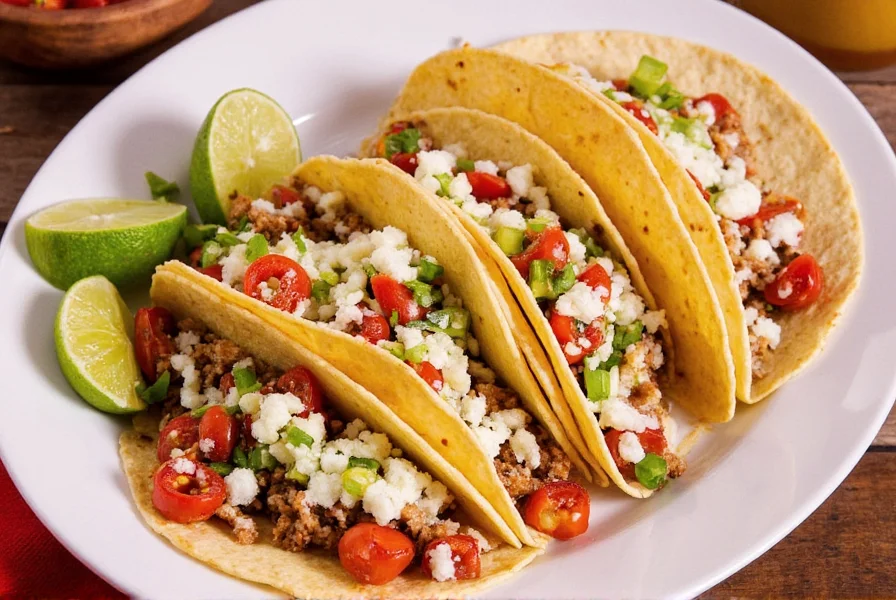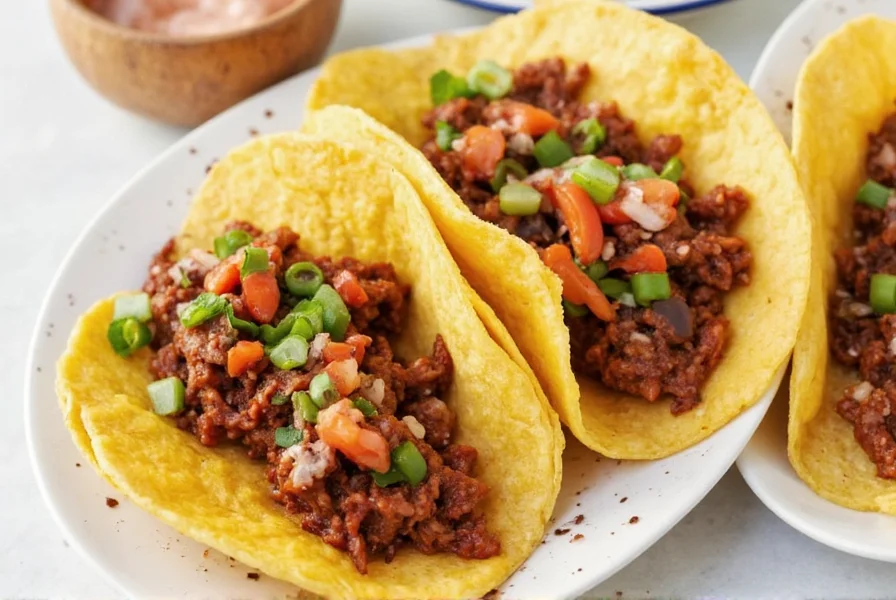| Chili Type | Heat Level (SHU) | Flavor Profile | Best Use Case | Where to Buy |
|---|---|---|---|---|
| Jalapeño | 2,500–8,000 | Grassy, bright | Fresh salsas, stuffed peppers | Supermarkets, farmers' markets |
| Serrano | 10,000–25,000 | Crisp, vegetal | Hot salsas, taco toppings | Mexican markets, specialty stores |
| Chipotle | 5,000–10,000 | Smoky, earthy | Marinades, slow-cooked fillings | Supermarkets, online retailers |
| Guajillo | 2,500–5,000 | Dried fruit, tea-like notes | Sauces, traditional Mexican recipes | Mexican markets, specialty stores |
| Ancho | 1,000–1,500 | Sweet, raisin-like | Mild sauces, mole | Mexican markets, online |
| Poblano | 1,000–1,500 | Mild, earthy | Stuffed peppers, fresh toppings | Supermarkets, Mexican markets |
What Are Chili Tacos? (And Why the Confusion?)
Many people search for "chili tacos" expecting a specific dish, but the term is often misunderstood. In authentic Mexican cuisine, there's no standard "chili taco" — instead, chilies are used as ingredients in various taco styles. The confusion typically comes from two sources:
- Chili con carne tacos: Tacos filled with chili con carne (a meat and bean stew)
- Tacos with chili peppers: Tacos featuring fresh or dried chilies as a primary flavor component
For this guide, we'll focus on the most common search intent: authentic Mexican-style tacos that use chilies as key ingredients, including traditional recipes, chili selection tips, and cooking techniques.
Top 5 Authentic Mexican Chili Tacos Recipes
1. Tacos al Pastor (Traditional Marinated Pork)
Originating from Mexico City, this iconic dish uses pineapple and achiote paste with guajillo and ancho chilies. The meat is traditionally cooked on a vertical spit (trompo) but can be made in a skillet.
- Heat Level: Medium
- Key Ingredients: Guajillo chilies, pineapple, achiote paste
- Authentic Tip: Always marinate for at least 4 hours for best flavor penetration
2. Carnitas Tacos with Chipotle Salsa
Braised pork shoulder slow-cooked until tender, served with a smoky chipotle salsa. This is one of the most popular street food tacos in Mexico.
- Heat Level: Mild-Medium
- Key Ingredients: Chipotle peppers in adobo, orange juice, cinnamon
- Authentic Tip: Use pork shoulder with bone-in for richer flavor
3. Tacos de Birria (Braised Goat or Beef)
A Jalisco specialty featuring tender meat in a rich, red chile sauce made from guajillo, ancho, and mulato chilies. Traditionally served with consommé for dipping.
- Heat Level: Medium
- Key Ingredients: Mulato chilies, dried oregano, bay leaves
- Authentic Tip: Simmer for 3+ hours to develop deep flavor
4. Tacos de Pescado (Fish Tacos with Chile de Arbol)
Coastal-style tacos featuring battered fish with a bright, spicy salsa made from fresh chile de arbol peppers.
- Heat Level: Medium-High
- Key Ingredients: Chile de arbol, lime, cabbage slaw
- Authentic Tip: Use fresh cod or mahi-mahi for best texture
5. Tacos de Barbacoa (Slow-Cooked Lamb or Beef)
Traditional barbacoa uses maguey leaves for steaming, but modern versions use oven cooking. The sauce features dried chilies for deep, complex flavor.
- Heat Level: Mild-Medium
- Key Ingredients: Dried guajillo and pasilla chilies, vinegar
- Authentic Tip: Cook for 8+ hours for fall-apart tenderness
Chili Buying Guide: What You Really Need to Know
When selecting chilies for tacos, focus on authenticity and flavor rather than just heat level. Here's what to look for:
- For fresh chilies: Look for firm skin with no wrinkles. Avoid chilies with soft spots or discoloration. Jalapeños and serranos should have bright green color (unless intentionally ripened to red).
- For dried chilies: Should be pliable, not brittle. A strong, pleasant aroma indicates freshness. Avoid chilies with mold or musty smell.
- Authentic Mexican chilies: Look for "guajillo," "ancho," and "mulato" on packaging — these are the most common in traditional recipes. Avoid "chili powder" blends unless specified as pure chili powder (many contain other spices).
Pro Tips for Perfect Chili Tacos Every Time
1. Toast Your Dried Chilies Properly
For maximum flavor, toast dried chilies in a dry skillet over medium heat for 15-30 seconds per side until fragrant. Then soak in hot water for 20 minutes before blending. This releases essential oils without burning.
2. Balance Heat with Acid
Traditional Mexican tacos always balance heat with acidity. Add fresh lime juice to salsas and use pickled red onions as a topping. The acid cuts through the richness and enhances the chili flavor.
3. Use the Right Tortilla
For authentic tacos, use corn tortillas (not flour). Warm them in a dry skillet for 15-20 seconds per side before serving. Double up tortillas for saucy fillings to prevent tearing.
4. Skip the Cheese (For Traditional Versions)
While cheese is common in Americanized versions, authentic Mexican tacos rarely include cheese. Instead, top with fresh cilantro, diced onions, and a squeeze of lime for traditional flavor.
Frequently Asked Questions
What's the difference between "chili" and "chilies" in taco recipes?
In Mexican cuisine, "chilies" (plural) refers to the fresh or dried peppers used as ingredients. "Chili" (singular) typically refers to chili con carne — a stew made with meat, beans, and chili powder. When searching for "chili tacos," most people mean tacos with chilies (peppers), not chili con carne. For authentic recipes, focus on dishes using specific chili varieties like jalapeño, guajillo, or chipotle.
Why do my tacos taste bland even with chilies?
Bland tacos usually result from not properly preparing the chilies. Dried chilies need to be toasted and soaked to release their full flavor. Fresh chilies should be roasted or charred to develop depth. Also, balance the heat with acid (lime juice) and salt. Traditional Mexican recipes often use a combination of multiple chilies for complex flavor profiles, not just one type.
What's the best chili for beginners making tacos?
Jalapeños are the best starting point for beginners. They're widely available, have moderate heat (2,500-8,000 SHU), and offer a bright, grassy flavor that works well in most taco applications. For dried chilies, start with guajillo (2,500-5,000 SHU) — they're flavorful but not too spicy, and they're commonly used in traditional Mexican sauces.
Can I make chili tacos without chilies?
By definition, no. "Chili tacos" specifically refers to tacos featuring chili peppers as a primary ingredient. If you want a non-spicy taco, you're looking for a different type of taco (like carne asada or al pastor without chilies). However, you can use mild chilies like poblanos or ancho peppers if you prefer less heat. Remember that "chili" in "chili con carne" refers to the stew, not the peppers — but this is a different dish from traditional Mexican chili tacos.

Final Thoughts
True chili tacos are an integral part of Mexican culinary tradition, where chilies are used to create complex flavors rather than just heat. By focusing on authentic preparation methods and selecting the right chili varieties, you can create tacos that capture the essence of Mexican street food. Remember: it's not about the hottest peppers, but about balancing flavors to create a harmonious dish.











 浙公网安备
33010002000092号
浙公网安备
33010002000092号 浙B2-20120091-4
浙B2-20120091-4